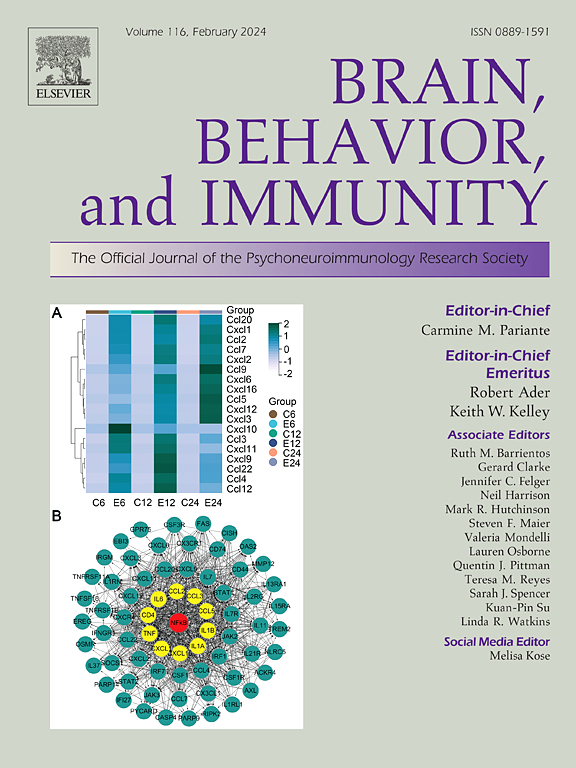探索免疫组学在抑郁症患者特征描述中的应用:概念验证研究
IF 8.8
2区 医学
Q1 IMMUNOLOGY
引用次数: 0
摘要
DNA 甲基化和炎症的改变可能是对重度抑郁症(MDD)患者进行分层的有效生物标志物。本研究探讨了在MDD和症状严重程度随时间变化的背景下,使用基于DNA甲基化的免疫细胞类型图谱。使用 Illumina Infinium MethylationEPIC 850 k BeadChip 对 119 名 MDD 患者的全血进行了 DNA 甲基化评估。使用 RnBeads 软件包进行了质量控制、数据处理和细胞类型估计。细胞类型组成是通过表观基因组范围的 DNA 甲基化特征来估算的,应用了 Houseman 方法,考虑了六种细胞类型(中性粒细胞、自然杀伤细胞(NK)、B 细胞、CD4 + T 细胞、CD8 + T 细胞和单核细胞)。对血清中的两种细胞因子(IL-6 和 IL-1β)和 hsCRP 进行了定量。我们对估计出的六种细胞类型进行了分层聚类分析,并检测了这些聚类与两种细胞因子和 hsCRP、基线抑郁严重程度以及 6 周治疗(塞来昔布/安慰剂+伏替西汀)后抑郁严重程度之间的差异。我们结合细胞类型和细胞因子进行了第二次聚类分析。方差分析用于检验不同聚类之间的差异。我们采用了 Bonferroni 校正。经过质量控制后,我们纳入了 113 名参与者。我们发现了两个集群,集群 1 的 CD4 + 细胞和 NK 含量高,集群 2 的 CD8 + T 细胞和 B 细胞含量高,中性粒细胞和单核细胞的比例相似。聚类与两种细胞因子和 hsCRP 或基线抑郁严重程度无关,但聚类 1 在 6 周后显示出较高的抑郁严重程度,并对基线进行了校正(p = 0.0060)。第二次聚类分析发现了类似的结果:聚类 1 的 CD8 + T 细胞、B 细胞和 IL-1β 含量较低。第 2 组的 CD4 + 细胞和自然杀伤细胞含量较低。中性粒细胞、单核细胞、IL-6 和 hsCRP 在群组之间没有差异。群组 1 的参与者基线抑郁严重程度高于群组 2(p = 0.034),但 6 周后抑郁严重程度无差异。基于DNA甲基化的细胞类型图谱可能对MDD患者的免疫学特征描述和分层很有价值。未来的模型应考虑纳入更多的细胞类型和细胞因子,以更好地预测治疗结果。本文章由计算机程序翻译,如有差异,请以英文原文为准。
Exploring the use of immunomethylomics in the characterization of depressed patients: A proof-of-concept study
Alterations in DNA methylation and inflammation could represent valid biomarkers for the stratification of patients with major depressive disorder (MDD). This study explored the use of DNA-methylation based immunological cell-type profiles in the context of MDD and symptom severity over time.
In 119 individuals with MDD, DNA-methylation was assessed on whole blood using the Illumina Infinium MethylationEPIC 850 k BeadChip. Quality control and data processing, as well as cell type estimation was conducted using the RnBeads package. The cell type composition was estimated using epigenome-wide DNA methylation signatures, applying the Houseman method, considering six cell types (neutrophils, natural killer cells (NK), B cells, CD4+ T cells, CD8+ T cells and monocytes). Two cytokines (IL-6 and IL-1β) and hsCRP were quantified in serum. We performed a hierarchical cluster analysis on the six estimated cell-types and tested the differences between these clusters in relation to the two cytokines and hsCRP, depression severity at baseline, and after 6 weeks of treatment (celecoxib/placebo + vortioxetine). We performed a second cluster analysis with cell-types and cytokines combined. ANCOVA was used to test for differences across clusters. We applied the Bonferroni correction.
After quality control, we included 113 participants. Two clusters were identified, cluster 1 was high in CD4+ cells and NK, cluster 2 was high in CD8+ T-cells and B-cells, with similar fractions of neutrophils and monocytes. The clusters were not associated with either of the two cytokines and hsCRP, or depression severity at baseline, but cluster 1 showed higher depression severity after 6 weeks, corrected for baseline (p = 0.0060). The second cluster analysis found similar results: cluster 1 was low in CD8+ T-cells, B-cells, and IL-1β. Cluster 2 was low in CD4+ cells and natural killer cells. Neutrophils, monocytes, IL-6 and hsCRP were not different between the clusters. Participants in cluster 1 showed higher depression severity at baseline than cluster 2 (p = 0.034), but no difference in depression severity after 6 weeks.
DNA-methylation based cell-type profiles may be valuable in the immunological characterization and stratification of patients with MDD. Future models should consider the inclusion of more cell-types and cytokines for better a prediction of treatment outcomes.
求助全文
通过发布文献求助,成功后即可免费获取论文全文。
去求助
来源期刊
CiteScore
29.60
自引率
2.00%
发文量
290
审稿时长
28 days
期刊介绍:
Established in 1987, Brain, Behavior, and Immunity proudly serves as the official journal of the Psychoneuroimmunology Research Society (PNIRS). This pioneering journal is dedicated to publishing peer-reviewed basic, experimental, and clinical studies that explore the intricate interactions among behavioral, neural, endocrine, and immune systems in both humans and animals.
As an international and interdisciplinary platform, Brain, Behavior, and Immunity focuses on original research spanning neuroscience, immunology, integrative physiology, behavioral biology, psychiatry, psychology, and clinical medicine. The journal is inclusive of research conducted at various levels, including molecular, cellular, social, and whole organism perspectives. With a commitment to efficiency, the journal facilitates online submission and review, ensuring timely publication of experimental results. Manuscripts typically undergo peer review and are returned to authors within 30 days of submission. It's worth noting that Brain, Behavior, and Immunity, published eight times a year, does not impose submission fees or page charges, fostering an open and accessible platform for scientific discourse.

 求助内容:
求助内容: 应助结果提醒方式:
应助结果提醒方式:


